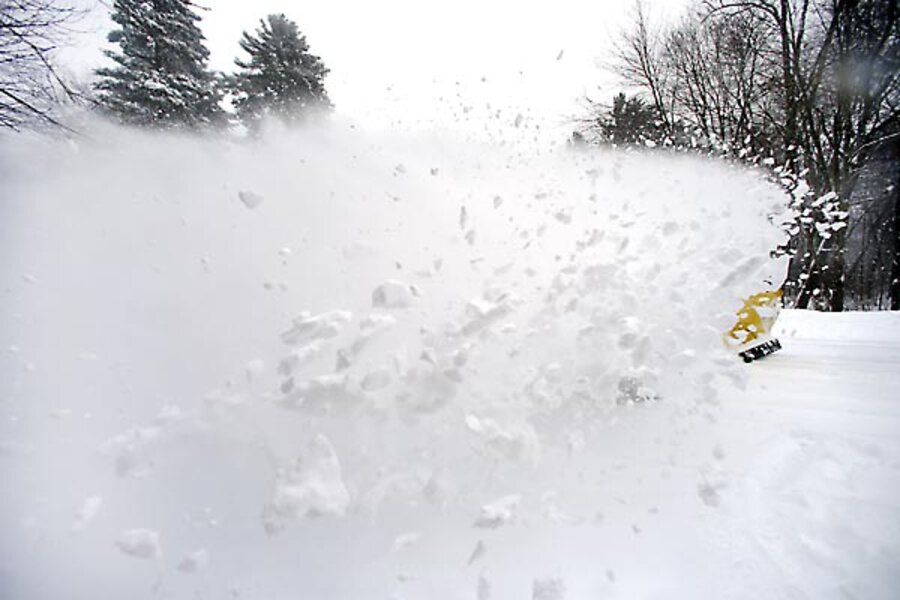Winter storm hits Northeast as emergency energy aid runs low
State agencies and nonprofits from Vermont to Iowa are struggling to keep up with a rising need for energy assistance as yet another winter storm rumbles across the United States.
After dumping snow, sleet, and freezing rain on Midwestern states Tuesday, the latest winter storm is bringing another blast of cold to the Eastern Seaboard. A winter storm warning is in effect for Pennsylvania, New York, and much of New England Wednesday, with states expected to receive anywhere from a few inches to a foot of snow.
This year's early string of winter storms has sapped the home energy assistance funds used to aid low-income households with utility payments during peak heating or cooling periods. State and local officials are supplementing federal aid with emergency dollars of their own and calling on President Obama to increase funding for the Low Income Home Energy Assistance Program (LIHEAP), the nation's primary source of home heating and cooling assistance.
"With these storms hitting – they’re just cutting a swath across the US," says John Rich, co-president of the National Energy and Utility Affordability Coalition, a coalition of nonprofits, utilities, and corporations that research and promote fuel funds. "It’s a tough winter for a lot of people."
Since LIHEAP funds are distributed at the state level, broad national data is difficult to come by, but Mr. Rich and others say demand for emergency heating aid is up after a bitterly cold January and a February that is not yet promising much relief. Fuel costs are soaring as the Midwest suffers a propane shortage and the Northeast grapples with bottlenecks in an aging natural-gas pipeline system. Residential heating systems, meanwhile, are working harder and longer to keep homes at safe temperatures.
Late last week, the US Department of Health and Human Services (HHS) released an additional $454 million of financial year 2014's total $3.4 billion in LIHEAP funding. It came as state LIHEAP directors warned of a strain on resources due to extreme winter conditions, according to a letter to directors from Jeannie Chaffin, director of the Office of Community Services at HHS. Last week's release is in addition to $2.9 billion in funding released last November.
Funds are distributed through local and state agencies and community action groups to low-income households for help with utility bills and low-cost weatherization. Eligibility varies from state to state but the maximum income level is generally set at 150 percent of the poverty level. The bulk of funding is released during winter months.
After hitting a recession-era peak of $5.1 billion in 2009, LIHEAP funding has slipped by a third to this year's $3.4 billion with some states offering supplemental support. In Iowa, legislators are pushing to appropriate $2 million in state funds to heating assistance amid sharp spikes in propane prices. Vermont is expected to chip in $8.1 million of its own funds in addition to the $16.9 million it receives from the federal government.
US Rep. Peter Welch (D) of Vermont and 124 other Democratic and Republican congressmen wrote a letter to President Obama last week urging him to fund LIHEAP's at no less than $4.7 billion in his fiscal year 2015 budget.
"We understand the ongoing discretionary budget challenges," the lawmakers wrote in the letter. "However, we are deeply concerned that funding for LIHEAP has declined more than 30 percent in recent years. Moreover, the number of households eligible for assistance continues to exceed available funding."
The average LIHEAP grant has been reduced by more than $100 since 2010, from $520 in FY 2010 to $406 in FY 2013, according to the letter. Meanwhile, the US Energy Information Administration projects that average winter heating expenditures this year will range from $679 to as high as $2,046, depending on location and fuel type.
As reliance on federal aid programs like food stamps and long-term unemployment benefits rise, critics contend that the programs are frequently exploited and do little to break the cycle of poverty. LIHEAP has also come under scrutiny for some reported scams, and some say the program merely uses taxpayer funds to subsidize utilities.
But instances of fraud are rare, Mr. Rich says in a telephone interview, and LIHEAP supports an essential service that is inextricably linked to maintaining healthy, productive households. What's more, the funding is temporary, and aid can come from other sources. Many utilities and other nonprofits have funds set aside for heating assistance.
"It’s not just federal dollars out there meeting the need, but it’s a big portion and it's an essential portion," Rich says. "It’s helping out your neighbor get through some tough times."
Residents in need of energy assistance can contact their local low-income energy office by calling the National Energy Assistance Referral toll-free at 1-866-674-6327 or TTY 1-866-367-6228 or by e-mailing energyassistance@ncat.org.






